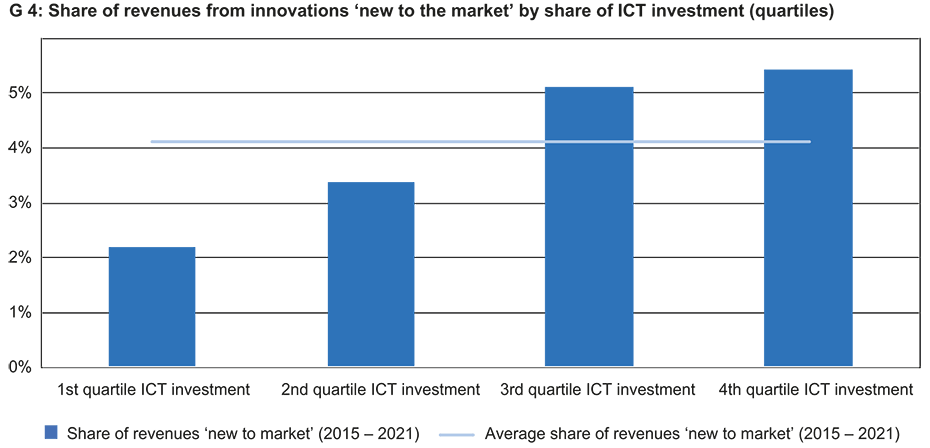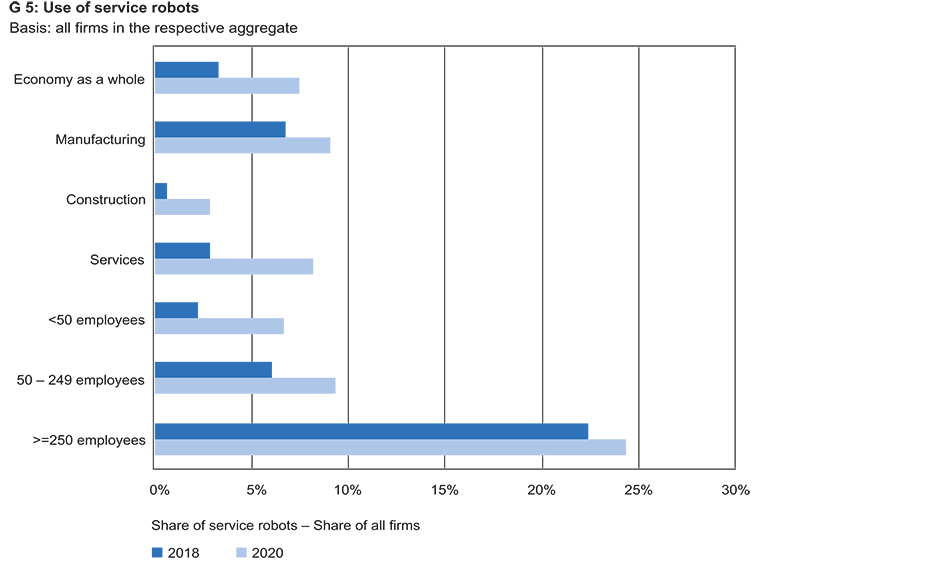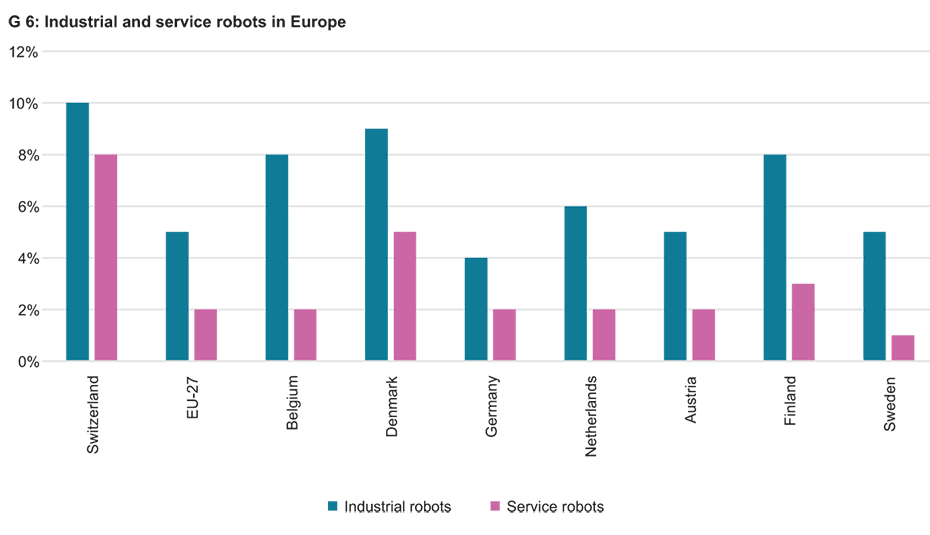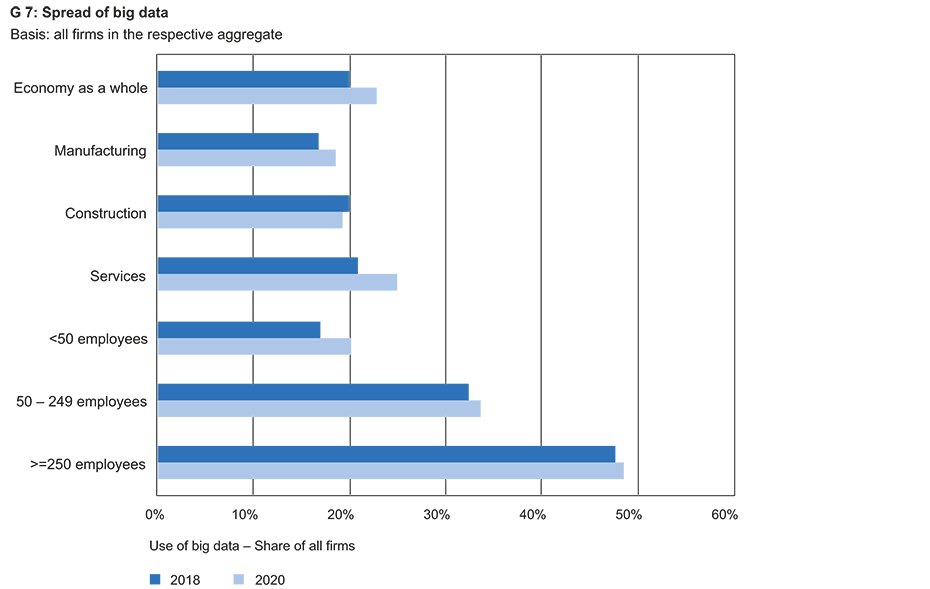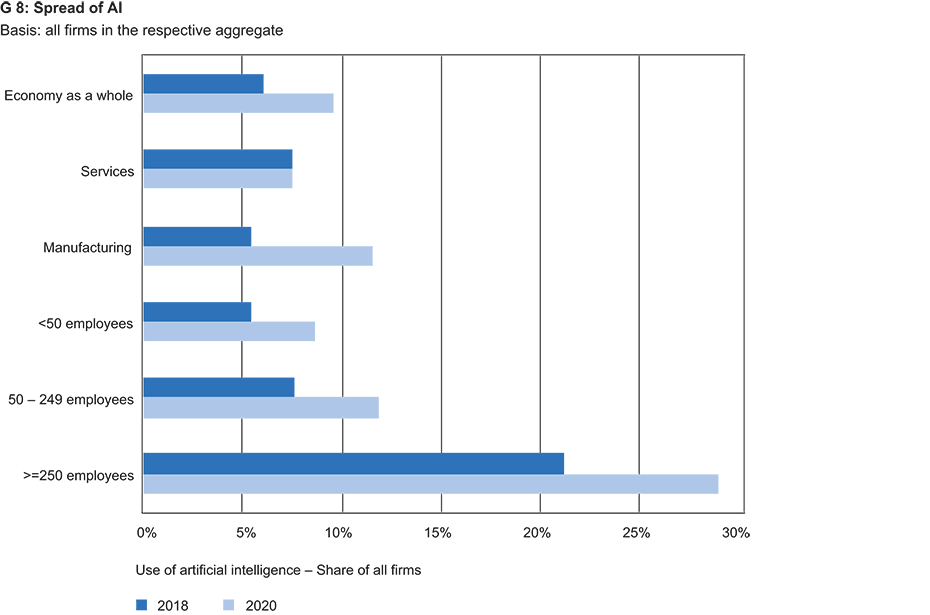
New digital technologies: what role do robots, big data and artificial intelligence play in the Swiss economy?
The spread of new digital technologies throughout the Swiss economy continues to increase. Robots, big data and artificial intelligence are being used not only to make internal processes more efficient, but also to develop and sell new products. This dual function keeps the Swiss economy competitive in the face of strong international competition.
ICT investment is boosting sales of new products
Investment in information and communication technology (ICT), i.e. hardware and software, accounts for about 17 per cent of total gross investment by companies in Switzerland. ICT investment is mostly used to make operational processes more efficient. However, firms use digital technologies not only for process optimisation but also to generate new products and services and sell them in the market. Chart G 4 shows that companies that invest heavily in ICT generate a significantly larger share of their revenues from product innovations that are new to the market. ICT investment thus helps to nurture not only process innovations within the company but also commercially more successful product innovations. New digital technologies such as big data analysis and artificial intelligence make it possible to give more consideration to customers’ preferences when innovating new products. At the same time, the automation of production through the use of industrial and service robots, for example, cuts production costs, which in turn reduces prices and increases the market penetration of these innovations. New digital technologies are on the rise in the Swiss economy, as this article will show.
The growing capabilities of industrial and service robots
Robots have become an indispensable part of the everyday operations at many companies. The application potential of robots has increased greatly over time. Whereas only simple, monotonous work was carried out by robots in the past, today they can perform complex precision tasks that could no longer be done manually. Robots are also being used more and more in the service sector. For example, they are involved in the transportation of goods, the cleaning of buildings and the monitoring of work processes. Accordingly, the use of service robots has risen sharply in the last two years, not only throughout the economy as a whole but also across all sectors and size categories of the Swiss economy (see chart G 5). The proportion of firms using service robots rose from 3 per cent in 2018 to 7 per cent in 2020. We have observed a similar increase at an even higher level in the share of companies employing industrial robots, which are used for work such as welding, cutting and spray painting.
High degree of automation compared with other countries
Switzerland has a high level of automation compared with other countries. Chart G 6 shows that, based on firms with more than ten employees, around 10 per cent of Swiss companies use industrial robots and around 8 per cent employ service robots . This means that Swiss firms are, on average, more highly automated than companies in countries that are generally highly digitalised such as Denmark, the Netherlands, Finland and Sweden. In these countries the penetration rate for industrial robots varies between 5 per cent and 9 per cent, while for service robots it ranges between 1 per cent and 5 per cent. The difference with Switzerland is therefore slightly more pronounced for service robots than it is for industrial robots. The relatively high wage levels and severe labour shortages in Switzerland will very likely strengthen the incentives to use fairly high levels of automation here.
Big data as the basis for process optimisation and product development
Companies often generate huge amounts of data in connection with their business activities. Analysis of big data enables firms to make use of this information. Such analysis can, for example, identify potential for cost savings by collecting data via sensors and evaluating it statistically. Analysis of big data can also facilitate data-based decision-making that supports firms’ strategic decision-making. Such analysis can help to develop new product ideas and increase the accuracy of marketing measures. Big data often forms the basis for using artificial intelligence. The following data sources are referred to here as big data: a) company-specific data from smart devices and sensors, b) geolocation data from portable devices, c) social media data and d) other big data sources. The proportion of firms using analytics based on big data increased over the period from 2018 to 2020. Chart G 7 shows that the share of companies using big data grew across all sectors and size categories. This proportion increased from 20 per cent to 23 per cent throughout the economy as a whole.
Artificial intelligence as a driver of automation
Artificial intelligence has disruptive potential in many areas of business. It offers possibilities such as early detection of machine failure and automated control of production systems. Companies also rely on artificial intelligence (AI) in product innovation and even in the design of new business models. AI is defined here as the ability for machines and systems to acquire and apply knowledge and to behave intelligently. It helps computers – like humans – to interact, understand and learn, thus enabling them to perform a variety of cognitive tasks that normally require human intelligence. Although its field of application is huge, relatively few companies are currently using AI. However, chart G 8 shows that the spread of artificial intelligence has grown sharply. While only 6 per cent of all firms were using artificial intelligence back in 2018, this figure had risen to 9 per cent by 2020. Among large companies this share was as high as almost 30 per cent in 2020.
Conclusion: digital technologies are improving firms’ productivity and competitiveness
The spread of digital technologies throughout the Swiss economy has continued to increase. Companies use these technologies to improve their productivity and financial performance. This requires complementary factors such as suitably skilled staff, organisational adjustments and secure technical infrastructure that mitigates the risk of failure of digitally supported production processes. Combined with new digital technologies, these operating conditions will improve the competitiveness of the company concerned and, ultimately, that of Switzerland.
The study entitled ‘Innovation and digitalisation in the Swiss private sector and results of the 2020 Innovation Survey’, on which this article is based, is available Downloadhere (PDF, 6.1 MB) (in German).
Contacts
KOF Konjunkturforschungsstelle
Leonhardstrasse 21
8092
Zürich
Switzerland
KOF Konjunkturforschungsstelle
Leonhardstrasse 21
8092
Zürich
Switzerland

